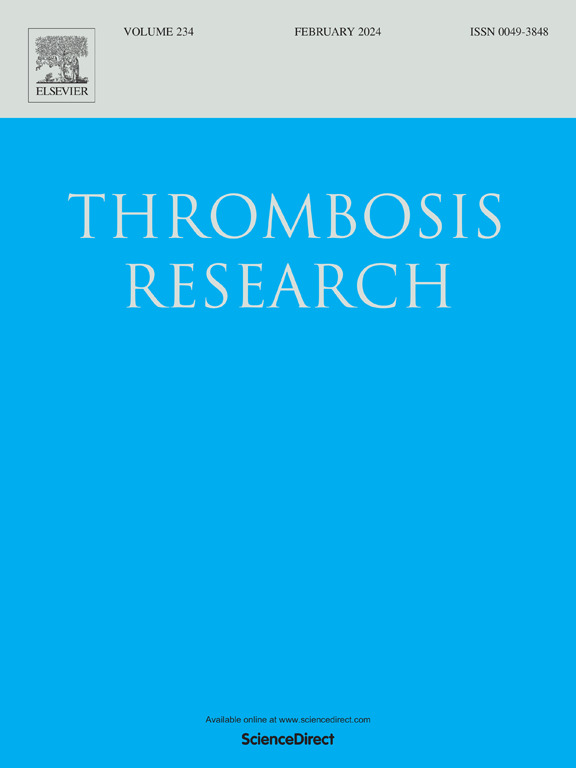Evolving patterns of intracranial hemorrhage in advanced therapies in patients with acute pulmonary embolism
IF 3.7
3区 医学
Q1 HEMATOLOGY
引用次数: 0
Abstract
Background
Dissecting trends and contributing risk factors for intracranial hemorrhage (ICH) in patients treated for acute pulmonary embolism (PE) may allow for a better patient selection for existing and emerging treatment options.
Methods
The German nationwide inpatient sample was screened for patients admitted due to PE 2005–2020. Hospitalizations were stratified for the occurrence of ICH; risk factors for ICH and temporal trends were investigated.
Results
Overall, 816,653 hospitalizations due to acute PE in the period 2005–2020 were analyzed in the study. ICH was reported in 2516 (0.3 %) hospitalizations, and time trend analysis revealed a fluctuating but overall, largely unchanged annual incidence. There was an increase of ICH with age. Patients with ICH had a higher comorbidity burden (Charlson-Comorbidity-Index [CCI], 5.0 [4.0–7.0] vs. 4.0 [2.0–5.0]; P < 0.001), and higher CCI was associated with an OR of 1.26 (95%CI 1.24–1.27) for ICH. Further independent risk factors for ICH were age ≥ 70 years (OR 1.23 [1.12–1.34]), severe (versus low-risk) PE (OR 3.09 [2.84–3.35]), surgery (OR 1.59 [1.47–1.72]), acute kidney injury (OR 3.60 [3.09–4.18]), and ischemic stroke (OR 14.64 [12.61–17.00]). The identified risk factors for ICH varied among different reperfusion treatment groups. As expected, ICH had a substantial impact on case-fatality of PE (OR 6.16 [5.64–6.72]; P < 0.001).
Conclusions
Incidence of ICH in patients hospitalized for acute PE in Germany was overall low and depended on the patients' comorbidity burden. Identifying patients at risk for ICH allows tailored patient selection for the different reperfusion treatments and might prevent ICH.
急性肺栓塞患者颅内出血在先进疗法中的演变模式
背景剖析急性肺栓塞(PE)患者颅内出血(ICH)的趋势和诱发风险因素,可以为现有和新出现的治疗方案提供更好的患者选择。研究对 2005-2020 年期间因急性 PE 住院的 816,653 例患者进行了分析。时间趋势分析显示,每年的发病率虽有波动,但总体上基本保持不变。随着年龄的增长,ICH的发病率也在增加。ICH 患者的合并症负担较重(Charlson-Comorbidity-Index [CCI],5.0 [4.0-7.0] vs. 4.0 [2.0-5.0];P < 0.001),较高的 CCI 与 ICH 的 OR 值 1.26(95%CI 1.24-1.27)相关。ICH 的其他独立危险因素包括年龄≥ 70 岁(OR 1.23 [1.12-1.34])、重度(相对于低风险)PE(OR 3.09 [2.84-3.35])、手术(OR 1.59 [1.47-1.72])、急性肾损伤(OR 3.60 [3.09-4.18])和缺血性卒中(OR 14.64 [12.61-17.00])。在不同的再灌注治疗组中,已确定的 ICH 风险因素各不相同。正如预期的那样,ICH 对 PE 的病死率有很大影响(OR 6.16 [5.64-6.72]; P < 0.001)。识别有 ICH 风险的患者可为不同的再灌注治疗选择量身定制的患者,并可预防 ICH。
本文章由计算机程序翻译,如有差异,请以英文原文为准。
求助全文
约1分钟内获得全文
求助全文
来源期刊

Thrombosis research
医学-外周血管病
CiteScore
14.60
自引率
4.00%
发文量
364
审稿时长
31 days
期刊介绍:
Thrombosis Research is an international journal dedicated to the swift dissemination of new information on thrombosis, hemostasis, and vascular biology, aimed at advancing both science and clinical care. The journal publishes peer-reviewed original research, reviews, editorials, opinions, and critiques, covering both basic and clinical studies. Priority is given to research that promises novel approaches in the diagnosis, therapy, prognosis, and prevention of thrombotic and hemorrhagic diseases.
 求助内容:
求助内容: 应助结果提醒方式:
应助结果提醒方式:


